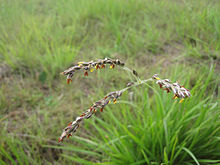Scientists have discovered that Grasses are smarter than other crops and are able to short cut evolution by stealing genes from their neighbors. Researchers from the Department of Animal and Plant Sciences at University of Sheffield have found that the grasses are breaking the evolutionary rules which has been based on common descent, where natural selection acts on the genes passed from parent to offspring. According to Dr. Luke Dunning, the lead investigators of this finding " Grasses are acting like sponge, absorbing useful genetic information from their neighbors to out compete their relatives and survive in hostile habitats without putting in millions of years it usually takes to evolve these adaptations.
These scientists have sequenced and assembled the genome of grass Alloteropsis semialata and published this paper in current issue of Proceedings of Natural Academy of Sciences.(Luke T Dunning et al., " Lateral transfers of large DNA fragments spread functional genes among grasses," PNAS (2019). http://www.pnas.org/cgi/doi/10.1073/pnas.1810031116).
These researchers compared the genome of this grass with approximately 150 other grasses( including rice, maize, millet, barley bamboo etc.) and they could not only identified genes in Alloteropsis semialata that were laterally acquired by comparing the similarity of the DNA sequences that make up the genes but could also track down when and where transfer happened by comparing the samples collected from tropical and subtropical places in Asia, Africa and Australia. This research shows that counterfeiting genes from neighbors is not restricted to Alloteropsis semialata only but detected in wide range of grasses that give them huge advantages to adapt to their surrounding environment and survive.
This findings will also help the society to reconsider how we view GM technology as grasses are naturally exploiting this technology and genetically modifying themselves to gain a competitive advantage.
Understanding the biological mechanisms behind this phenomenon may also help the scientists reducing the risk of genes escaping from GM crops into local wild plants and creating so called "Super-weeds".

Alloteropsis semialata
Alloteropsis semialata, commonly known as black seed grass or cockatoo grass (distributed across much of tropical, subtropical Africa, Asia and Australia) is a unique grass both genetically as well as physiologically. This species has been found in polyploid series with diploid, tetraploid, hexaploid and octaploid individuals. The species has two subspecies including A. semialata, which uses C4 photosynthetic pathway and sub species A. eckloniana which uses C3 photosynthetic pathway which is a evolutionary reversion from C4 to C3 photosynthesis. As the only plant species known to include both C3 and C4 genotype, it is an important model plant for the study of evolution of photosynthesis.
Thanks for sharing
ReplyDeleteWonderful information
Thanks for share nyc informayion
ReplyDeleteV well explained Sir
ReplyDeleteThank you ma'am for sharing the information 😇😇
ReplyDelete